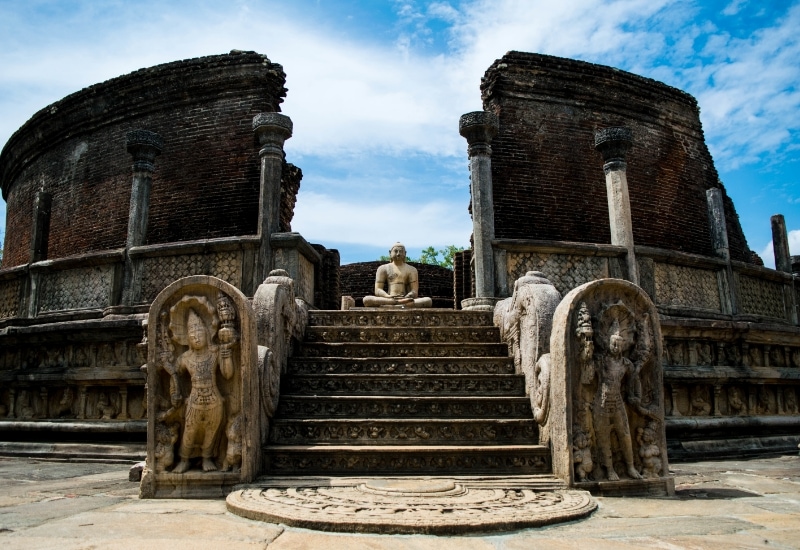
Cycling through the Ancient City of Polonnaruwa and hike up Dhanigala (Alien Rock)
Sri LankaAfter our road trip to Anuradhapura a while back the next destination on our list was Polonnaruwa. Naz was on the lookout for a weekend to plan it and lucky for us we had a 4 day weekend. Ideal. After discussing the details of the trip we decided to cover Polonnaruwa as well as another destination that was on our bucket list – Dhanigala aka Alien Rock. While looking at the route I realized that Dhanigala was in close proximity to Passikudah! So it was set – we’d go to Polonnaruwa first, climb Dhanigala next and end the trip relaxing in Passikuda. And this time we’d take Jehan along as he’d be absolutely livid if we didn’t.
The Drive to Polonnaruwa
We started off from Wellawatte in our car at 4pm on a Wednesday evening. Since Thursday and Friday were holidays, we decided to leave a little early to avoid the traffic. Jehan was assigned the first driving shift (we have pre-designated drivers for specific “legs” of the drive). We took the Katunayake Expressway and, after a brief stop in Seeduwa, started for Polonnaruwa via Kurunegala and Dambulla. After getting through the initial evening rush hour traffic we were able to keep up a fairly steady pace until we stopped for dinner in Dambulla at around 9PM. We had Kottu. It wasn’t that great – too many pieces of bones to pick out. Why can’t people just make boneless Kottu? After the meal, Naz took over driving from Dambulla to Polonnaruwa.
Driving on these roads is certainly a treat as the road quality is pretty good and traffic is free flowing. Be weary of the high speed at which you and the other vehicles will be driving though – especially in the night. You will come across quite a number of larger vehicles – buses, lorries, trucks and other commuter traffic flying along the roads at high speeds. So please be careful, and if you feel sleepy, park away from the main road and rest your eyes a bit. A 20 min nap will make you feel refreshed for the rest of the drive. The other factor you have to keep an eye out for are Elephants. The Dambulla – Polonnaruwa road goes right through the Minneriya National Park and you will find notices on the sides of the road warning of wild elephants. Keep your eyes peeled in these areas as it can be rather difficult to make out the figure of the dark frame of an elephant against the dark of the night. If you do see an Elephant on the side of the road, do not stop to take pictures or feed them. Just keep going. You should only stop the vehicle if the elephant is blocking the road.
We reached Polonnaruwa by about 10.30 pm and caught a great sight just before entering the hotel. – a herd of about 20 deer crossed the lane we were driving on! Although this was a fairly residential area, this kind of occurrence is common.
Wild Lodge Polonnaruwa
Our space for the next two nights was Wild Lodge Polonnaruwa. It’s a 5 minute drive from the hotel to the ancient city and is a small quaint place with 6 rooms which can accommodate 3-4 people each and one tree house which can accommodate two. The rooms were clean and fairly spacious with most of the basic amenities – TV, A/C and a large bathroom and an abundance of power points to plug in your electronics. The next morning we poked our heads into the tree house as well (it wasn’t occupied). Built on a tree (obviously) with the bathroom and a small dining area on the first level and the room a level higher, the room was quite small with just the bed and a mosquito net (sorry no AC) but would be just right for a couple that’s feeling a little adventurous.
Polonnaruwa
Polonnaruwa is the capital of the North Central Province of Sri Lanka and lies about 6 hours drive from Colombo. Situated in the dry zone, Polonnaruwa has a primarily agriculture based economy with large swathes of paddy fields and chena plantations. The Parakrama Samudraya acts as its main source of water, but the whole region is littered with hundreds of small lakes and “tanks” which provide the much needed water for irrigation purposes in the area. The origin of Polonnaruwa dates back to the 11th century when it was the capital of the Kingdom of Polonnaruwa until 1310 CE. The ancient city of Polonnaruwa is the primary attraction with its ruins of palaces, temples and religious figures from Buddhism and Hinduism scattered across an area of around 7 square kilometres.
Touring Polonnaruwa on bicycle
After a hearty breakfast of string hoppers, sambol and parippu in the morning we set out to embark on our tour of the ancient city by cycling in Polonnaruwa. There is a bicycle rental spot on the side of the road opposite to the entrance. We parked our car under a tree and got ourselves a mountain bike each. The bikes cost Rs. 300.00 each per day and were in fairly good condition. Let me be clear though, these aren’t fancy bikes with all the bells and whistles (literally no bell) – they are the basic models with the standard gear and front and back brakes. Don’t be shy to ask for a different bike if the one you got doesn’t feel right. (We had one with slippery handles grips.)
The tour starts off with entry into the Ancient City through its main gate. You can explore on foot, on a bicycle or drive into the area as well. We decided cycling was the more fun, environmentally friendly and healthier method. Although the whole area is fairly flat, cycling around isn’t entirely a breeze as there are sections which are slightly elevated. You can ride very close to most of the attractions, park on the grassy embankments and explore the ruins on foot.
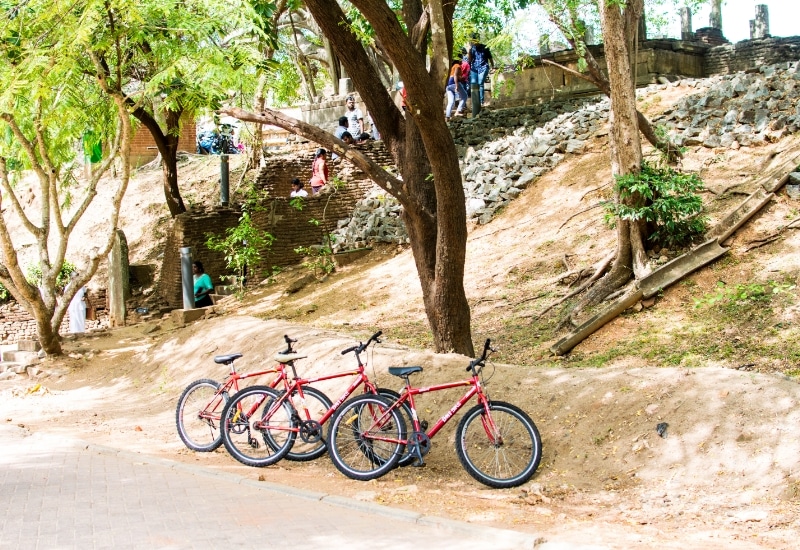
King’s Palace
The first main attraction is the Palace premises. This is said to have been a 7 story building, built by King Parakramabahu I (1153 – 1186). Presently only the skeleton of the palace is intact. This is a common theme along most of the ruins as they were primarily built using wood leaving behind the foundation and first floor consisting of brick and mortar where you can see the various rooms, parts of staircases and toilettes.
Next you come across the Kumara Pokuna or the Prince’s pond, which includes the main pond and a changing room.
The Council chamber is next with its distinct carved pillars lining the sides. It is said that the councilmen would sit on each side with the king on the throne in the middle. When someone was to speak he would have to walk to the middle section of the chamber, hence only the person speaking would be directly visible to the king.
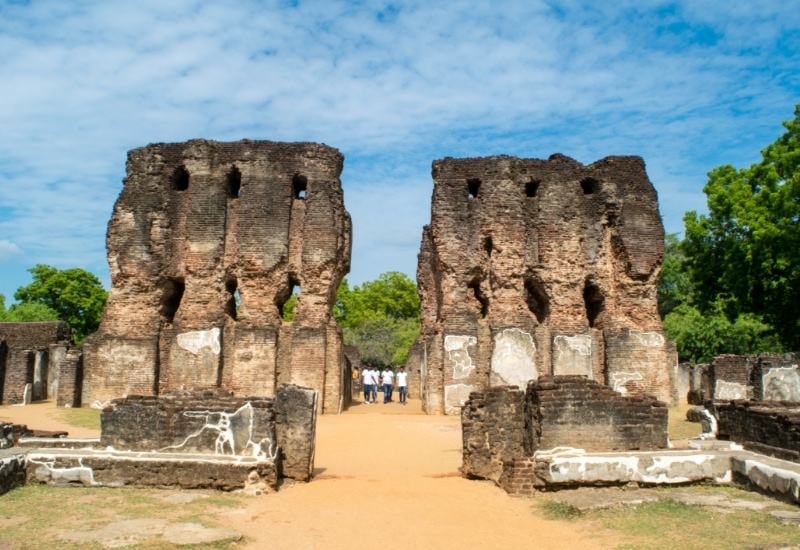



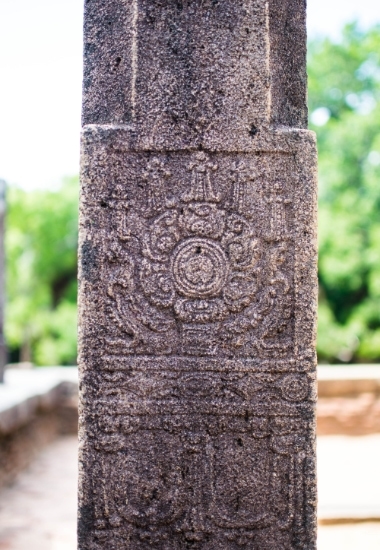

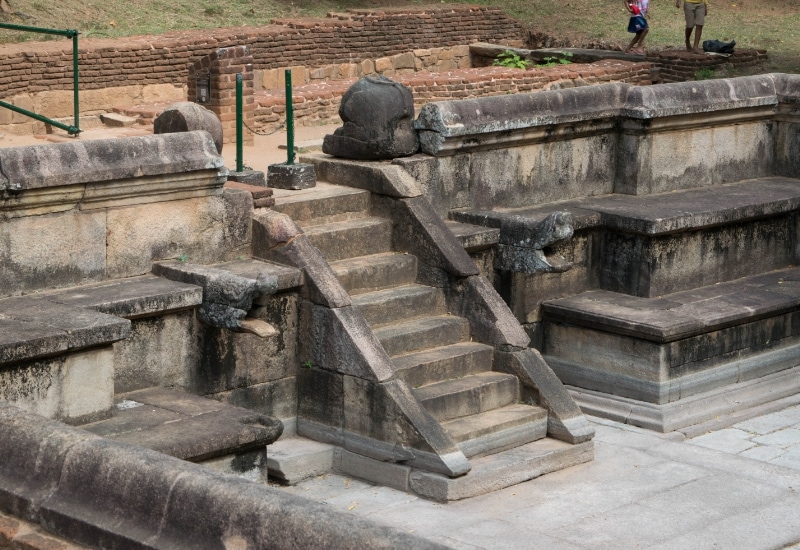

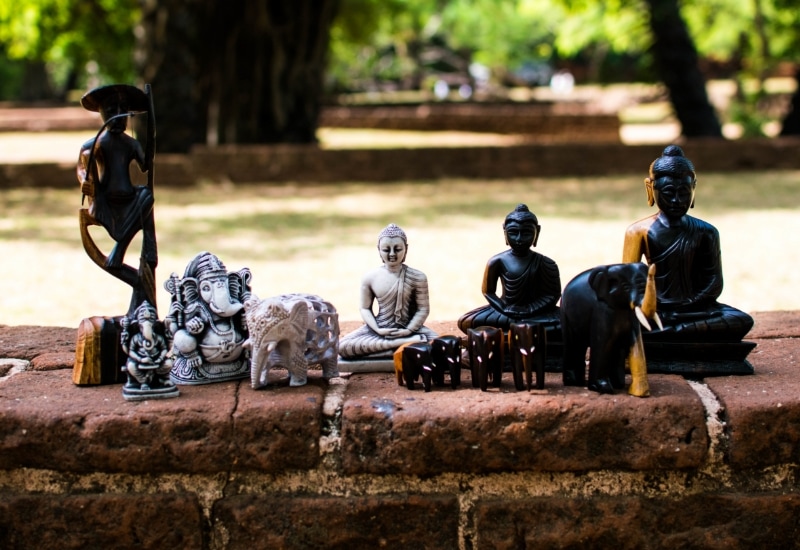

Dalada Maluwa and Vatadagaya
Moving on from here we made our way to the Dalada Maluwa or the Sacred Quadrangle. This area contains the Vatadagaya or the temple in which is believed to have housed the sacred tooth relic during the time of King Parakramabahu. The tooth relic is believed to be the sacred tooth of the Lord Buddha and in the ancient times, it was necessary to lay claim to the tooth relic in order to gain control of the kingdom. In addition several other temples including a hindu temple, an ancient inscription plaque and a Seven storied prasadaya are also located here. We spent quite a bit of time here as there was a lot to see and many pictures to take.
Two things to remember when in Sri Lanka, near Buddhist temples and buddha statues is that you must cover up to your shoulders and knees and that you cannot take photographs with your back turned towards the statue. Both are considered disrespectful and you’re sure to get a reminder from one of the officials on duty.

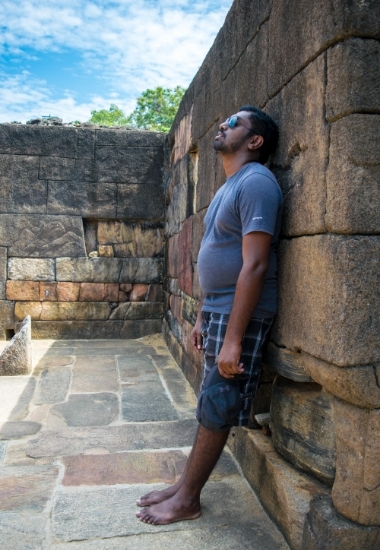
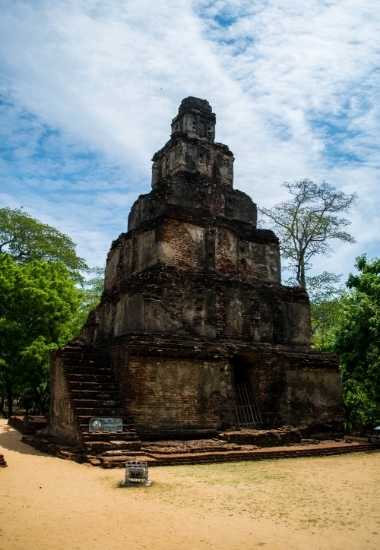
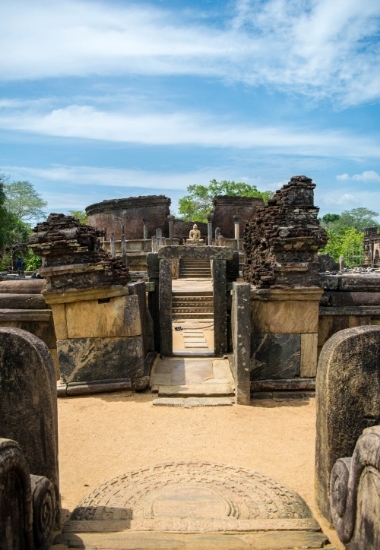

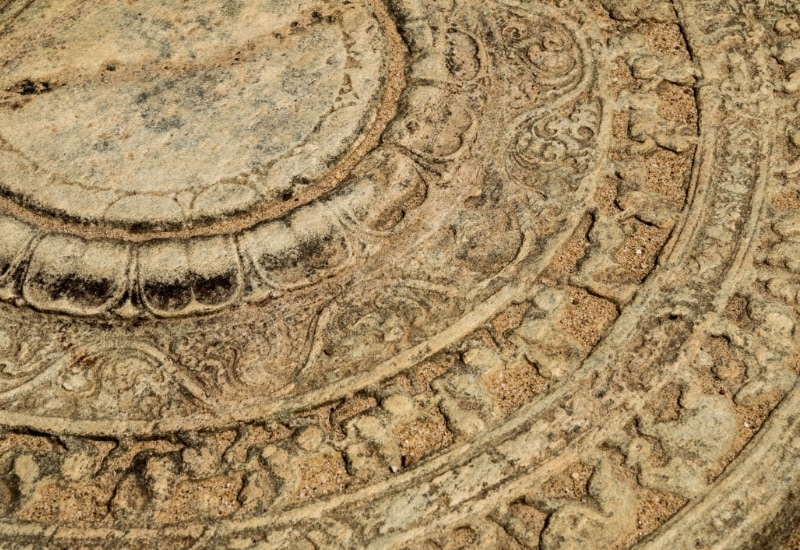
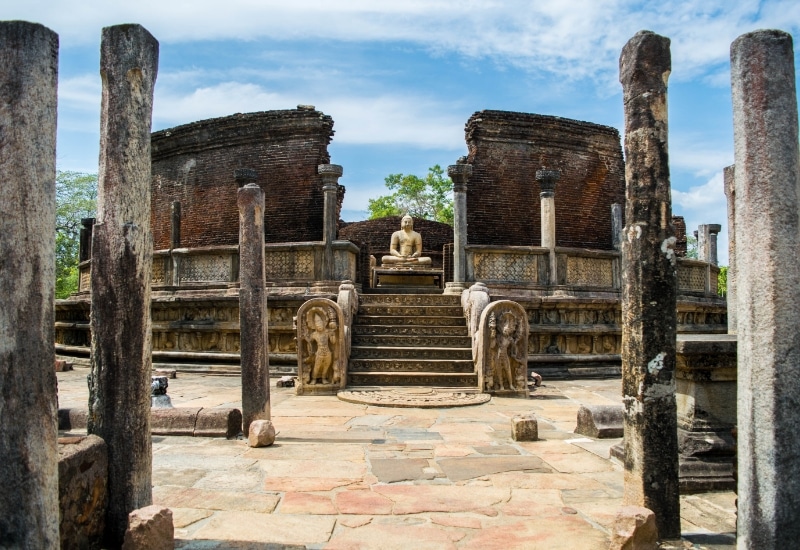
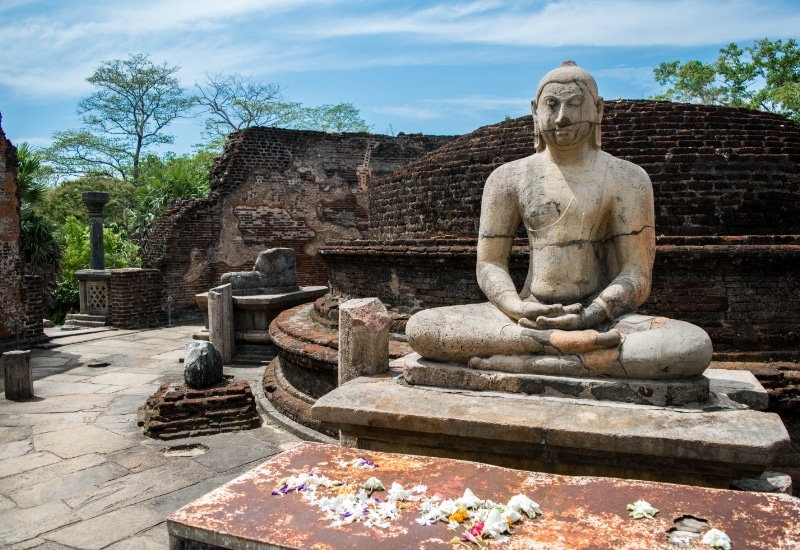

Since it was high noon by this time, and very hot, we decided to take a break and enjoy a cold drink of King Coconut and Lime Juice from one of the stalls nearby. Both these drinks are absolutely amazing at keeping you hydrated under the heat and humidity of Sri Lanka.
After this very welcome cool-off we proceeded to cycle further North, past the boundaries of the ancient city walls. Here you find the Rankot Viharaya, Lankathilaka and KiriVehera. The Rankoth Viharaya is the largest pagoda in ancient Polonnaruwa with a height of 33m, although it is believed to have originally been at a height of almost 60m. Built by King Nissankamlla in the 12th century, the stupa has similarities with the Ruwanweli Seya in Anuradhapura.
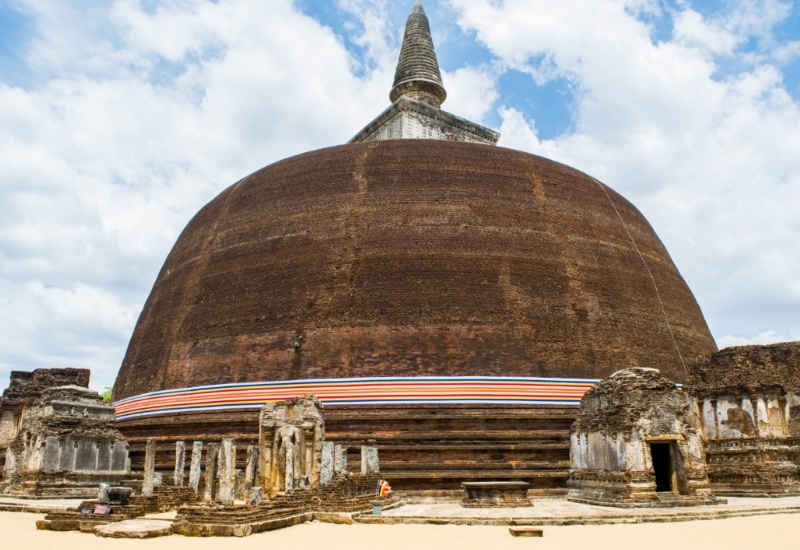
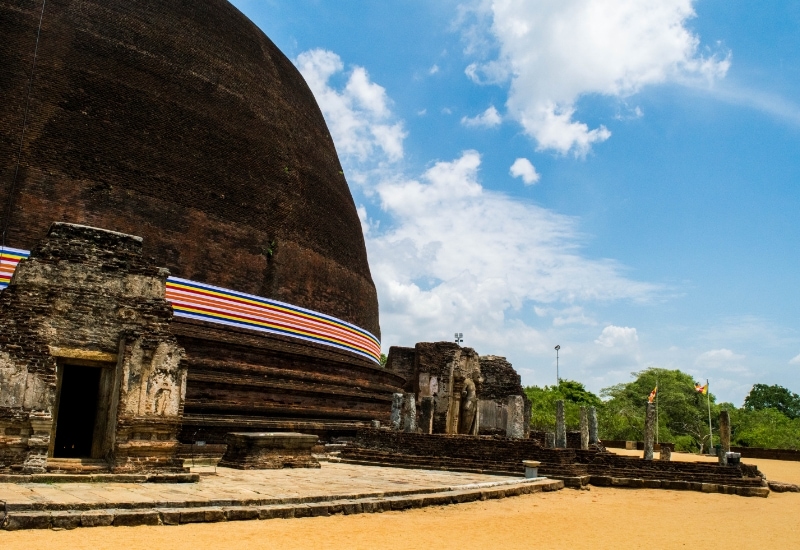
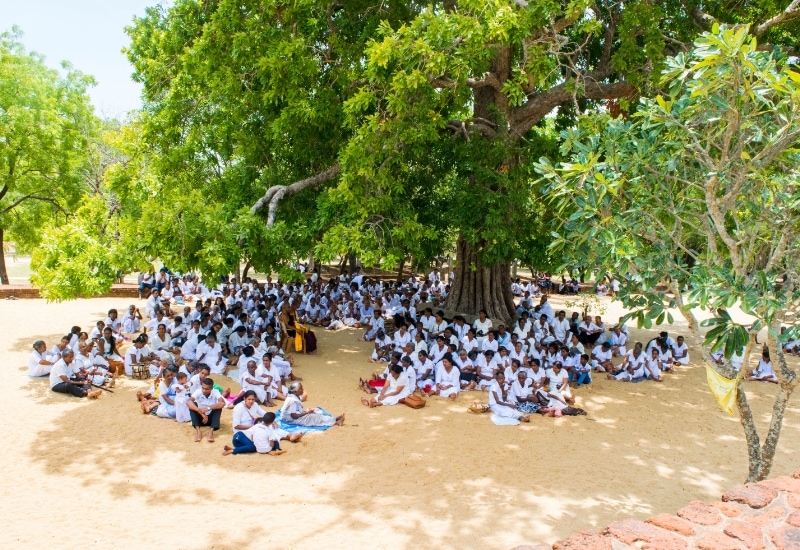
Lankathilakaya
Lankathilakaya is fast becoming one of those instagrammable destinations in Polonnaruwa. The construction houses a massive statue of the Lord Buddha and although the roof of the structure is no more, it gives the feeling of a cathedral. Next to it is the Polonnaruwa Kiri Vehera, which should not be confused with the Kiri Wehera of Kataragama. This stupa was constructed in the 12th century by one of the queens. It is one of the rare stupas that was found relatively well preserved when discovered after 900 years in the jungle.
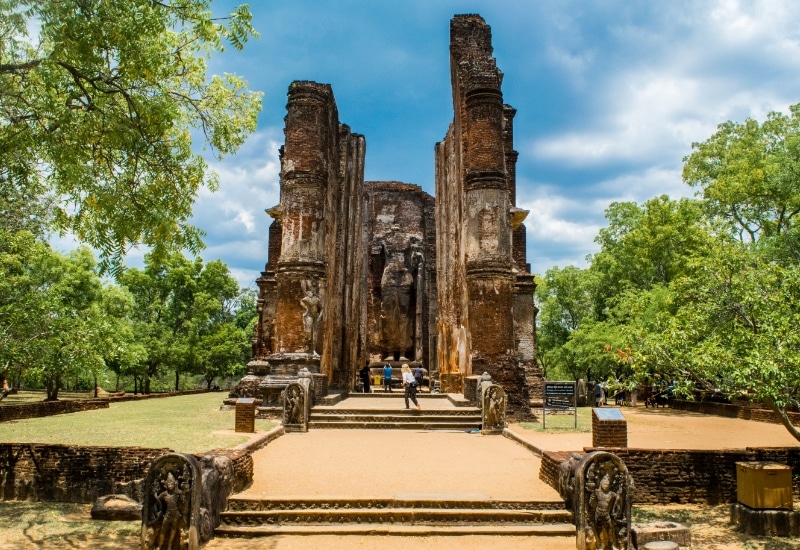
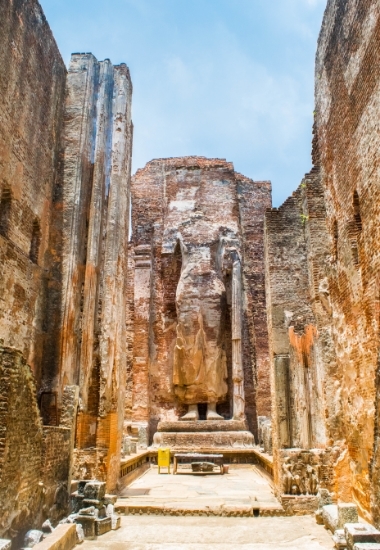
Gal Viharaya
Following these we took a long ride down to where the Gal Viharaya is located. We parked our bikes at the car park next to one of the small shops and walked the rest of the way. The Gal Viharaya consists of three Buddha statues and a small shrine carved out of pure rock. It is one of the most beautiful pieces of craftsmanship that can be found in Polonnaruwa. The three statues all depict the Lord Buddha in different stances – standing, meditating and laying down. It is believed that the one of him lying down is actually depicting him upon death. In front of the carvings there is another rock which has an interesting story attached to it. It is said that an English hunter had shot at the lying down statue, resulting in a crack which can still be seen. The shot was taken from the top of the rock and apparently, he was killed by an elephant immediately afterwards.
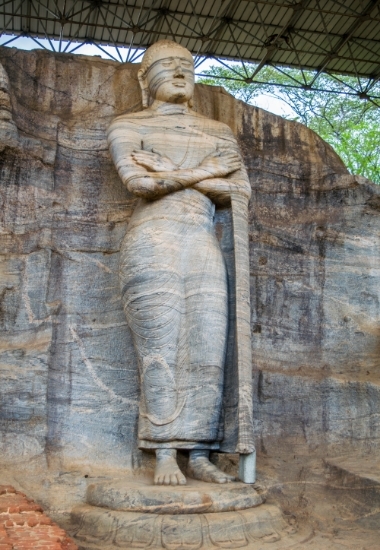

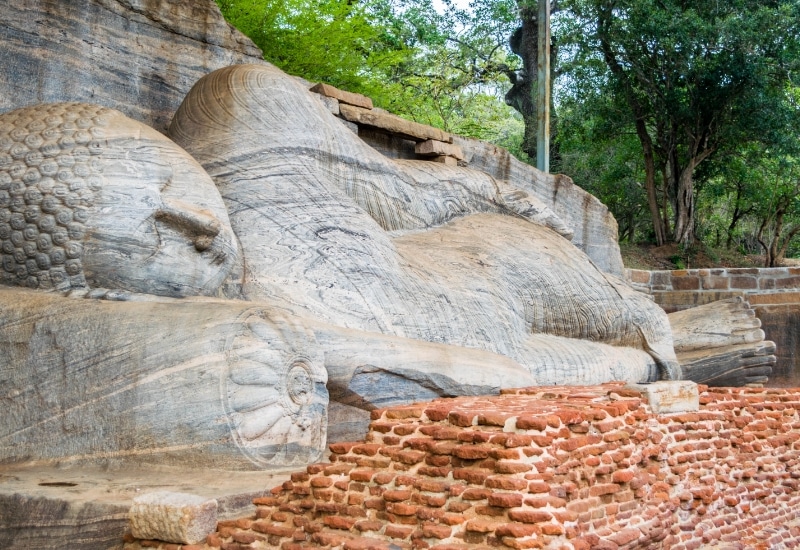
Thivanka Image House
We refuelled on some cold king coconut and started our way towards the final attraction on the list, the Thivanka Image House. This lies about 1.5 Kms away from everything else and the road has a few slopes up and down. It was a challenging ride, especially in the heat, but we made our way to it. The outside of the Thivanka Image house is adorned with beautiful rock carvings – most of which have been renovated. Inside there is a statue of the Buddha with the interior walls adorned with intricate artwork. Unfortunately only some of it has been preserved till now. You are not allowed to take photographs inside this ruin.

Then we began the long ride back to the bicycle park – all the way back to the entrance. Since it was late evening we put in an order for some dinner and retired to our room.
Dhanigala a.k.a. Alien Rock
The next day we woke up early in the morning and had a hearty breakfast from the hotel. String hoppers, Pol Sambol and curry – yummay. Dhanigala was about 50kms south east from Polonnaruwa – a drive of about 1 ½ hours. It was my turn to drive and I was looking forward to the relatively clear well paved roads. This was the case for half of the drive, the rest though was an absolute nightmare. A large portion of the road leading to Dhanigala was under construction which meant Potholes all over the road! With shadows of trees falling across the road it was even more difficult to drive as you had to really strain your eyes to make out the shadows from the potholes. A good 10km of the road was like that and we had to drive a lot slower to navigate this stretch. Eventually though we found our way to the Kandegama Kanda Viharaya – the temple situated at the foot of Dhanigala.
Kandegama Kanda Viharaya
Dating back to the 2nd century CE, The Kandegama Kanda Lena Viharaya ruins are situated within the natural rock formation as two caves lying one on top of the other on the path towards the top of Dhanigala.
The main cave houses a large reclining Buddha statue measuring around 5.5 metres in length made of brick and clay, and is similar to the statues found at Pidurangala. Unfortunately the statue has been vandalised by treasure hunters. Several inscriptions can be found carved onto the rock. One such inscription refers to King Saddhatissa and his son with the names of donors of the caves also being cut into the caves.

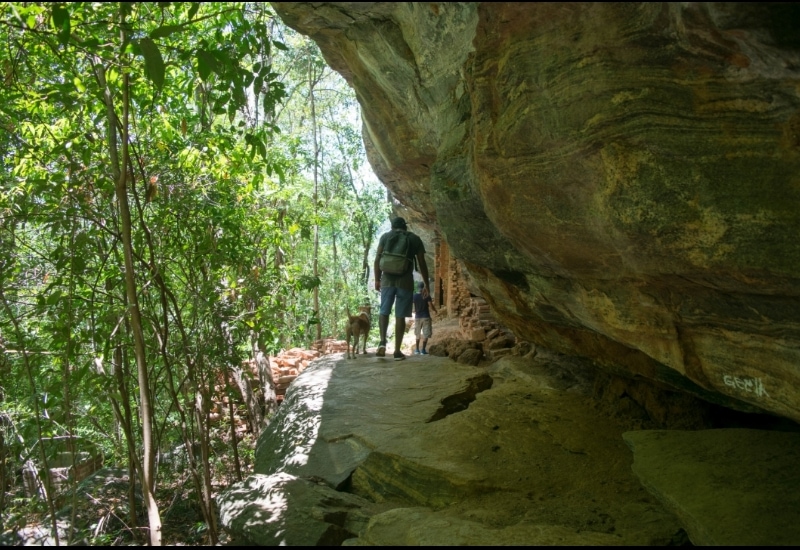
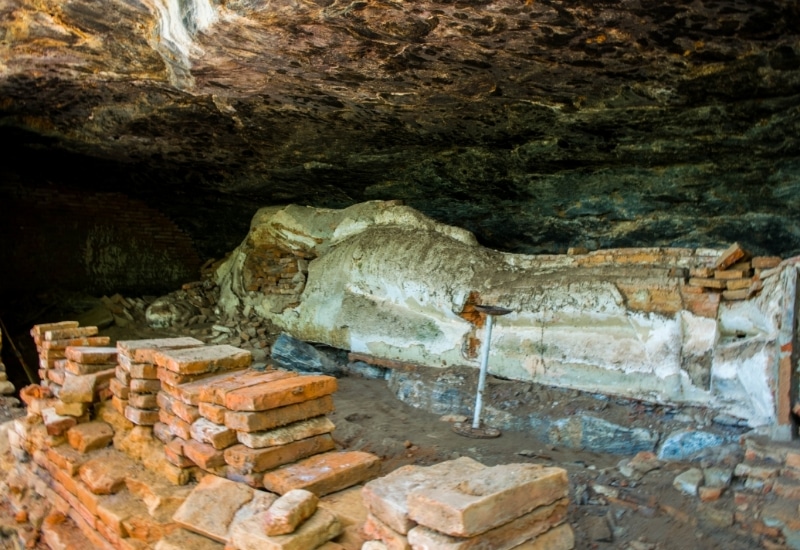
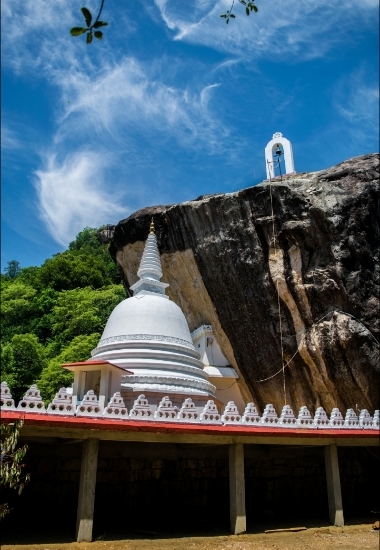
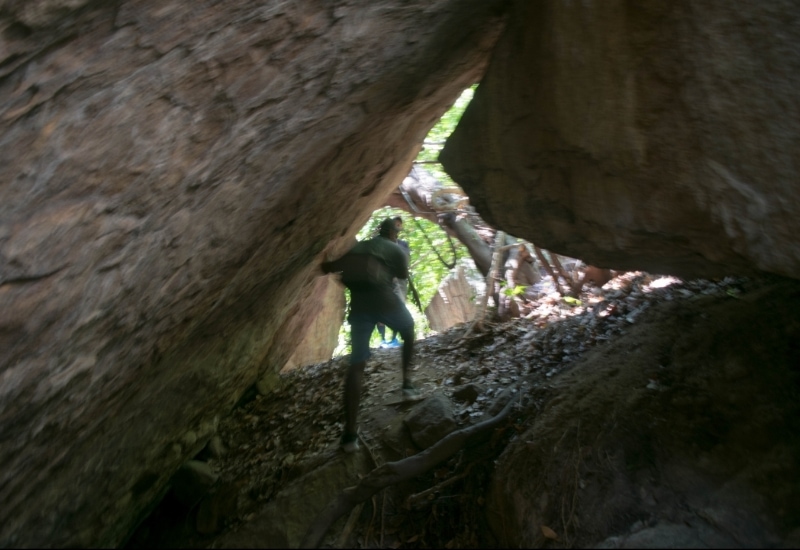
Climbing (and losing our way) up Dhanigala
After giving our identification details to the temple priests we started our way up the Dhanigala rock. There is a small pathway with stone steps at the start of the climb eventually leading towards the main rock itself. You need to take the path towards the left from here. Follow this path with the rock to your right and you will come across the rock caves housing the statue of the sleeping Buddha. A little further on you’ll come into a fairly steep descent along a jagged path. When we reached this place we were unsure whether to keep going on it as it went downwards and away from the rock itself, but based on track maps we’ve seen before we knew the path went around the rock for some way before winding upwards towards the peak. So we kept along this route and eventually came to a point when the path climbed up again leading to a slight incline of flatter rock.
At this point we lost track of the path. Although all three of us have been on quite a few treks we couldn’t figure out clearly where we had to go on from here. So we decided to take a short break and drink some water. Whilst doing this I realized that our 2 dog companions looked fairly tired as well – so we poured some water into a small crack on a rock – they lapped up the water happily. Now we had to find our way up. This is when I saw our companions trotting into the trees. I told my two friends to stay where they were while I went behind the dogs to see where they were going. Unsurprisingly, after walking behind them for about 50 metres I could make out the path again. I quickly called out to my friends and they followed my path. Not long after the tree line broke and we were greeted with a flatter section of rock and brush. I knew then that we had reached the top of Danigala.
By this point the time was about 12 noon. We had been climbing for about 1 ½ hours to reach the top and it was extremely bright and hot. The top of Dhanigala is circular with a rocky lip right around and a small brush area in the middle – like the top of a bald man’s head but in reverse. This unique layout has given rise to theories that its a location where flying saucers land. Hence the name “Alien Rock”. Villages claim to have seen bright lights on top of the rock as well. I can only report that we did not meet any extraterrestrials during our brief visit. Maybe we should have made an appointment first.
We walked right around it and sat under one of the larger trees for shade and rested for a few minutes. We weren’t tired but the heat was quite energy sapping. A few photographs and a failed attempt to fly the borrowed drone later we decided to make our way back down. Interestingly, although I had the tracked map on me to follow, we couldn’t find the entrance/exit point from the top of the rock for a few minutes. But after we found it we steadily made our way back to the foot of the rock – which took about 45 minutes. In order to show our appreciation to the 2 doggos that took us up and down our journey we gave them some biscuits.
Chilling in Kalkudah
After refilling our water bottles we set off on our long drive towards Kalkudah. We usually use Google Maps on our drives and take the most straightforward route. On this particular drive, besides the main route, Naz showed a different one that followed the path of an irrigation canal. We decided to throw caution to the wind and take it. That was a fun little adventure as we ended up emerging out of that road onto a small sluice gate where people were taking a dip. Since we too were quite tired from the hike and the drive we decided to get in a quick dip before setting off on the rest of the drive.
We ran into a thunderstorm halfway through and I could barely see out of the windscreen – we finally got to Passikudah at about 5pm only for the hotel that we had booked to inform us that they had given our room to someone else because we didn’t check in at 2. They never even attempted to contact us to check if we were arriving. Extremely unprofessional. After looking online for another option we came across Kay Jay Kalkuda. It was a bit more expensive than we had planned but did come with a better view of the beach and a pool. So we decided to crash there for the night. As per usual me and Naz woke up early to catch the sunrise and take some photographs. And after breakfast we checked out with Nazeer taking over the job of driving back home.
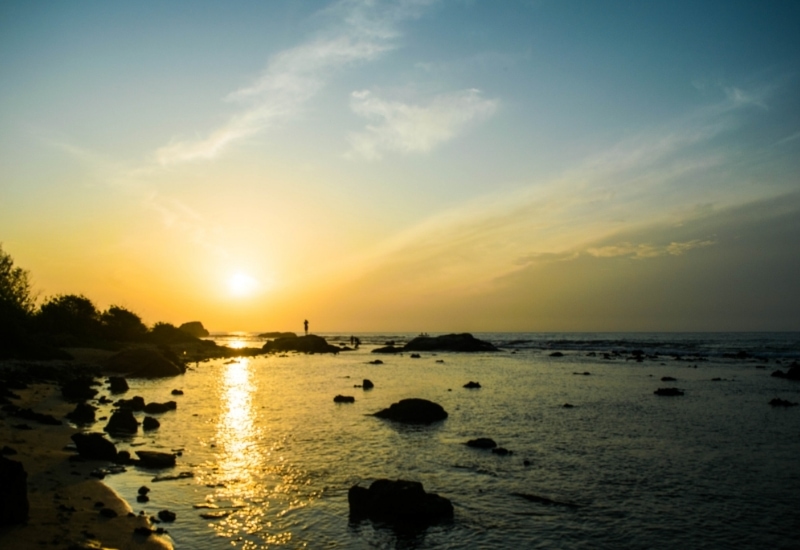
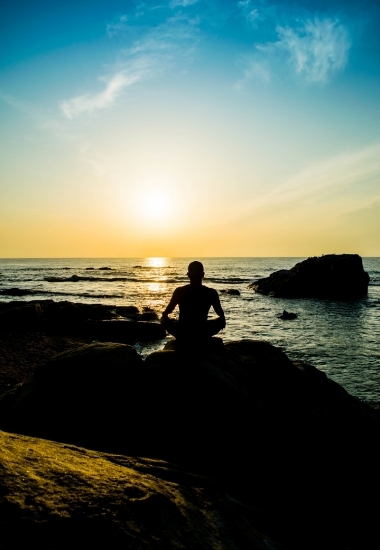
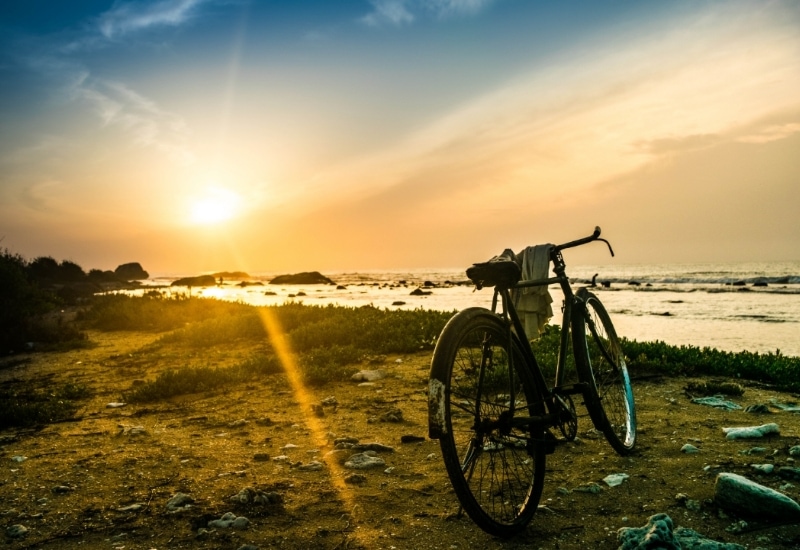

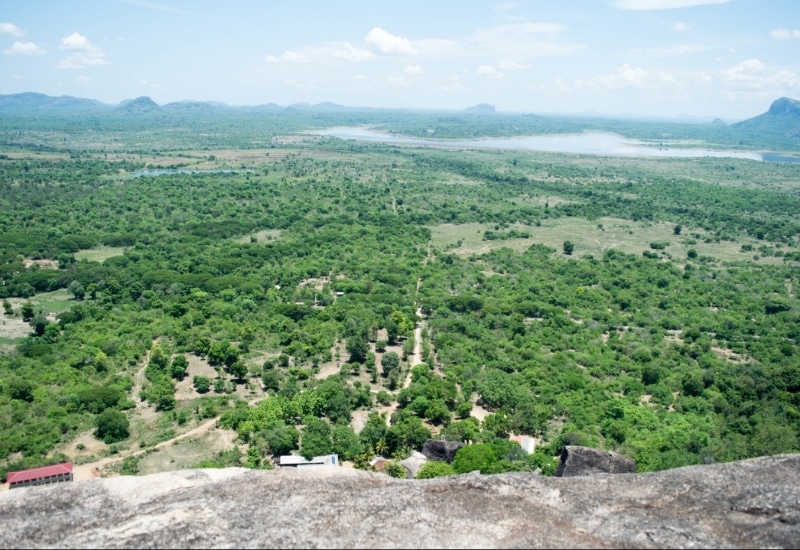
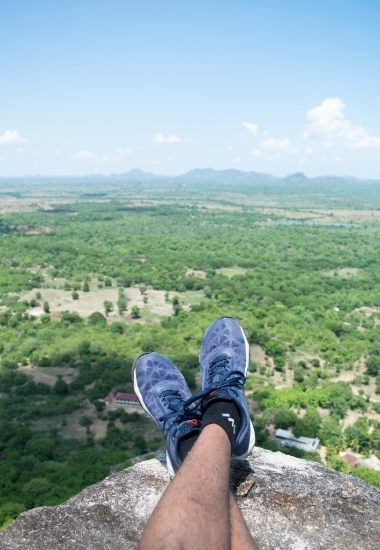


Wowwww into details, what a adventurous days.. once all this crisis gone, we should go another one..